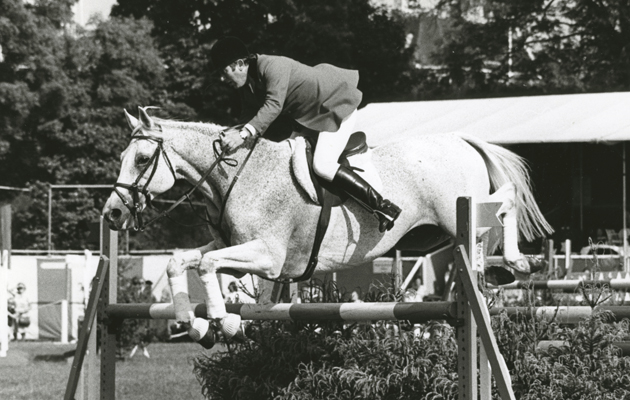H&H showjumping editor Jennifer Donald spoke to British Showjumping chief executive Iain Graham to find out about the work being carried out towards the full resumption of sport
British Showjumping (BS) has been one of the first equestrian sports to return competitively as the country slowly emerges from the coronavirus lockdown.
Behind the scenes at the sport’s governing body, a skeleton staff has made mammoth efforts, through ever-changing government guidelines, to ensure members are back out enjoying the sport. The path ahead remains long, but in the meantime competitors are familiarising themselves with this new look show circuit.
“These are not normal shows, these are shows run under restrictions, and organisers and members just need to remember that when they rock into their familiar venue,” BS chief executive Iain Graham told H&H.
“But we’ve been fortunate how restrictions have lifted for our sport and that we’ve had organisers who have been willing to work under the new restrictions.”
{"content":"PHA+QWZ0ZXIgdGhlIHN1Y2Nlc3Mgb2YgdHJhaW5pbmcgc2hvd3Mg4oCUIHRoZSBmaXJzdCBwaGFzZSBvZiByZW9wZW5pbmcgcG9zdC1sb2NrZG93biDigJQgbG93ZXIgbGV2ZWwgY29tcGV0aXRpb25zIGhhdmUgYmVlbiBydW5uaW5nIHNpbmNlIHRoZSBtaWRkbGUgb2YgSnVuZS48L3A+CjxwPjxkaXYgY2xhc3M9ImFkLWNvbnRhaW5lciBhZC1jb250YWluZXItLW1vYmlsZSI+PGRpdiBpZD0icG9zdC1pbmxpbmUtMiIgY2xhc3M9ImlwYy1hZHZlcnQiPjwvZGl2PjwvZGl2PjxzZWN0aW9uIGlkPSJlbWJlZF9jb2RlLTMxIiBjbGFzcz0iaGlkZGVuLW1kIGhpZGRlbi1sZyBzLWNvbnRhaW5lciBzdGlja3ktYW5jaG9yIGhpZGUtd2lkZ2V0LXRpdGxlIHdpZGdldF9lbWJlZF9jb2RlIHByZW1pdW1faW5saW5lXzIiPjxzZWN0aW9uIGNsYXNzPSJzLWNvbnRhaW5lciBsaXN0aW5nLS1zaW5nbGUgbGlzdGluZy0tc2luZ2xlLXNoYXJldGhyb3VnaCBpbWFnZS1hc3BlY3QtbGFuZHNjYXBlIGRlZmF1bHQgc2hhcmV0aHJvdWdoLWFkIHNoYXJldGhyb3VnaC1hZC1oaWRkZW4iPg0KICA8ZGl2IGNsYXNzPSJzLWNvbnRhaW5lcl9faW5uZXIiPg0KICAgIDx1bD4NCiAgICAgIDxsaSBpZD0ibmF0aXZlLWNvbnRlbnQtbW9iaWxlIiBjbGFzcz0ibGlzdGluZy1pdGVtIj4NCiAgICAgIDwvbGk+DQogICAgPC91bD4NCiAgPC9kaXY+DQo8L3NlY3Rpb24+PC9zZWN0aW9uPjwvcD4KPHA+4oCcVGhlcmUgd2VyZSBwbGFucyBBIGFuZCBCIGJ1dCBJIHRoaW5rIHdl4oCZcmUgaGFsZndheSB0aHJvdWdoIHRoZSBhbHBoYWJldCBub3cgZnJvbSB0aGF0IG9yaWdpbmFsIHBsYW5uaW5nLOKAnSBNciBHcmFoYW0gc2FpZC48L3A+CjxwPuKAnFRoZXJlIGFyZSBhbHNvIHBsYW5zIGluIGEgZHJhd2VyIHRoYXQgd2UgaG9wZSB3aWxsIGNvbWUgb3V0IGluIEp1bHkgYW5kIEF1Z3VzdCwgYnV0IHRoZXJlIGFyZSBvdGhlciBwbGFucyB3ZSBtYXkgbm90IHNlZSB0aWxsIG5leHQgeWVhci48L3A+CjxwPuKAnEJ1dCB3ZeKAmWQgaGFkIGEgZ29vZCAxMCBkYXlzIG9mIHRyYWluaW5nIHNob3dzIHdvcmtpbmcgd2l0aCBmZWVkYmFjayBmcm9tIG9yZ2FuaXNlcnMsIGNvbXBldGl0b3JzIGFuZCBvZmZpY2lhbHMgYWJvdXQgdGhlaXIgZXhwZXJpZW5jZSBhdCB0aG9zZSB0cmFpbmluZyBzaG93cyBhbmQgdGhhdCB3YXMgd2h5IHdlIG1hbmFnZWQgdG8gZ2V0IHRoYXQgYXBwcm92YWwgZm9yIGl0IHRvIGJlIHJvbGxlZCBvdXQgaW50byBhIGNvbXBldGl0aW9uIGVudmlyb25tZW50LuKAnTwvcD4KPGRpdiBjbGFzcz0iYWQtY29udGFpbmVyIGFkLWNvbnRhaW5lci0tbW9iaWxlIj48ZGl2IGlkPSJwb3N0LWlubGluZS0zIiBjbGFzcz0iaXBjLWFkdmVydCI+PC9kaXY+PC9kaXY+CjxwPk1yIEdyYWhhbSBoYXMgc3RlZXJlZCBzaG93anVtcGluZyBvdXQgb2YgbG9ja2Rvd24gdW5kZXIgdGhlIGdvdmVybm1lbnTigJlzIG1heGltdW0gb2Ygc2l4IHBlb3BsZSBtZWV0aW5nIHJ1bGUsIHJhdGhlciB0aGFuIHRocm91Z2ggZWxpdGUgc3BvcnQgZ3VpZGFuY2UuPC9wPgo8cD7igJxXZSByZWFsaXNlZCB0aGF0IFt0aGUgZWxpdGUgcm91dGVdIHdhcyBvbmx5IGF2YWlsYWJsZSBmb3IgYSB2ZXJ5IHJlc3RyaWN0ZWQgbnVtYmVyIG9mIGF0aGxldGVzIGluIHRoaXMgY291bnRyeSzigJ0gaGUgc2FpZC4g4oCcV2UgYWxzbyBzYXcgdGhlIGNvc3RzIGZvciBwcmVtaWVyIGxlYWd1ZSBmb290YmFsbCBhbmQgZm9yIGhvcnNlIHJhY2luZyBhbmQsIHRvIHJ1biBhbiBlbGl0ZSBqdW1waW5nIGNvbXBldGl0aW9uLCB0aGUgY29zdHMgd291bGQgaGF2ZSBiZWVuIHNpZ25pZmljYW50IGZvciB3aG9ldmVyIHdhcyBvcmdhbmlzaW5nIGl0LuKAnTwvcD4KPGRpdiBjbGFzcz0iYWQtY29udGFpbmVyIGFkLWNvbnRhaW5lci0tbW9iaWxlIj48ZGl2IGlkPSJwb3N0LWlubGluZS00IiBjbGFzcz0iaXBjLWFkdmVydCI+PC9kaXY+PC9kaXY+CjxwPlRocm91Z2hvdXQgbG9ja2Rvd24gdGhlcmUgaGFzIGJlZW4gY29uc3RhbnQgZGlhbG9ndWUgYmV0d2VlbiBCUyBhbmQgb3JnYW5pc2VycywgbmF0aW9uYWwgZnVuZGluZyBib2RpZXMsIEJyaXRpc2ggRXF1ZXN0cmlhbiAoQkVGKSBhbmQgdGhlIG90aGVyIGVxdWVzdHJpYW4gc3BvcnRzIHRvIGVuc3VyZSBhbGlnbm1lbnQg4oCUIGFsdGhvdWdoIHZhcnlpbmcgcmVzdHJpY3Rpb25zIGluIGVhY2ggb2YgdGhlIGhvbWUgY291bnRyaWVzIGFkZHMgYW5vdGhlciBjaGFsbGVuZ2UuPC9wPgo8cD7igJxXZSBuZWVkIHRvIHNob3cgdGhhdCB3ZSBhcmUgcmVzcGVjdGluZyB0aGUgZ3VpZGFuY2UgdGhhdCBpcyBvdXQgdGhlcmUgYWJvdXQgbnVtYmVycywgbWluaW1pc2luZyB0cmF2ZWwgYW5kIGNvbnRhY3QsIG1haW50YWluaW5nIHNvY2lhbCBkaXN0YW5jaW5nIGFuZCBkb2luZyBhbGwgd2UgY2FuIHRvIHN0b3AgdGhlIHNwcmVhZCBvZiB0aGUgdmlydXMsIHdoaWxlIHN0YXJ0aW5nIHRvIGVuam95IG91ciBob3JzZXMgYWdhaW4s4oCdIE1yIEdyYWhhbSBzYWlkLjwvcD4KPGRpdiBjbGFzcz0iYWQtY29udGFpbmVyIGFkLWNvbnRhaW5lci0tbW9iaWxlIj48ZGl2IGlkPSJwb3N0LWlubGluZS01IiBjbGFzcz0iaXBjLWFkdmVydCI+PC9kaXY+PC9kaXY+CjxwPuKAnFdl4oCZcmUgaGVscGluZyB0aGUgdmVudWVzIGRvIHRoaXMsIHNvIHdl4oCZcmUgbm90IGNoYXJnaW5nIHRoZW0gYWZmaWxpYXRpb24gZmVlcyBmb3IgdGhlIHNob3dzIHRoZXnigJlyZSBydW5uaW5nIGluIHRoaXMgcGVyaW9kIGFuZCB3ZeKAmXZlIG1hZGUgYXZhaWxhYmxlIGZyZWUgdGlja2V0cyBmb3IgcGVvcGxlIHdobyBhcmVu4oCZdCBjdXJyZW50IG1lbWJlcnMgb3IgdGhlaXIgaG9yc2VzIGFyZW7igJl0IHJlZ2lzdGVyZWQuIFBlb3BsZSBuZWVkIHRvIGdldCB0aG9zZSB0aWNrZXRzIGluIGFkdmFuY2Ugc28gd2UgaGF2ZSB0aGVpciBjb250YWN0IGRldGFpbHMgaWYgdGhlcmXigJlzIGEgcmVxdWlyZW1lbnQgdG8gdHJhY2sgYW5kIHRyYWNlLjwvcD4KPHA+4oCcQWx0aG91Z2ggd2Ugd2VyZW7igJl0IHJlY29yZGluZyByZXN1bHRzIGZyb20gdGhlIHRyYWluaW5nIHNob3dzLCB3ZSB3ZXJlIGFza2luZyBmb3IgdGhvc2UgcmVzdWx0cyB0byBiZSBzdWJtaXR0ZWQgdXNpbmcgdGhlIGp1ZGdpbmcgc3lzdGVtIHNvIHRoYXQgd2UgaGFkIHRoZSByZWNvcmQgb24gb3VyIGRhdGFiYXNlIG9mIHdobyBoYWQgYmVlbiB0aGVyZS7igJ08L3A+CjxwPuKAnFdlIGhhZCBsb3RzIG9mIGRpc2N1c3Npb25zIGFyb3VuZCB0aGUgcHJhY3RpY2FsaXRpZXMs4oCdIE1yIEdyYWhhbSBhZGRlZC4g4oCcVGhlIGFyZWEgb2YgcGFydGljdWxhciBjb25jZXJuIHdhcyBpbiB0aGUgd2FybS11cCwgYW5kIG9uZSBvZiB0aGUgYXJlYXMgdGhlIGdvdmVybm1lbnQgd2FzIHZlcnkgcGFydGljdWxhciBhYm91dCB3YXMgdGhlIHNoYXJpbmcgb2YgZXF1aXBtZW50IGFuZCBoYXZpbmcgbWluaW1hbCBjb250YWN0IHdpdGggcGllY2VzIG9mIGVxdWlwbWVudCwgaGFuZHMgdG91Y2hpbmcgYW5kIHNvIG9uLiBUaGF04oCZcyB3aHkgd2UgY2FtZSBkb3duIHdpdGggb25lIHBlcnNvbiBpbiB0aGUgd2FybS11cCBhcmVuYSwgb3ZlcnNlZWluZyB0aGUgcHJhY3RpY2Ugb2JzdGFjbGVzLCBhbmQgdGhlbiBiZWluZyBhYmxlIHRvIG9wZXJhdGUgd2l0aCBhIGdyb3VwIG9mIGZpdmUgcmlkZXJzLCBwdXR0aW5nIHRoZW0gdGhyb3VnaCBpbiBiYXRjaGVzIG9mIGZpdmUgc28gdGhleSB3ZXJlbuKAmXQgbWVldGluZyBtb3JlIHRoYW4gc2l4IHBlb3BsZSBpbiB0aGF0IGdyb3VwLjwvcD4KPHA+4oCcVGhlcmUgd2VyZSBzb21lIG9yZ2FuaXNlcnMgdGhhdCBmZWx0IHRoYXQgcmVzdHJpY3Rpb24ganVzdCB3YXNu4oCZdCB2aWFibGUgZm9yIHRoZWlyIHZlbnVlcyBhbmQgZXF1YWxseSB3ZSBoYXZlIHNvbWUgbGFyZ2VyIHZlbnVlcyB3aG8gaGF2ZSBzdGFmZiBmdXJsb3VnaGVkIGFuZCBkdWUgdG8gdGhlIHVuY2VydGFpbnRpZXMgYXJvdW5kIHRoZSByZXN1bXB0aW9uIGFuZCBob3cgSnVseSBtaWdodCBsb29rLCB0aGV5IHdlcmUgcmVsdWN0YW50IHRvIGJyaW5nIHN0YWZmIGJhY2suPC9wPgo8cD7igJxUaGUgbWVzc2FnaW5nIHN0aWxsIGNvbWluZyBvdXQgb2YgZ292ZXJubWVudCBhbmQgdGhlIG1lZGljYWwgb2ZmaWNlcnMgYWR2aXNpbmcgdGhlcmUgaXMgdGhhdCB3ZSBzaG91bGQgZXhwZWN0IGEgc2Vjb25kIHdhdmUgb3Igc3Bpa2UuIFNvIHdoYXQgd2XigJl2ZSBiZWVuIHJlbGF5aW5nIHRvIG91ciBvcmdhbmlzZXJzIGlzIGp1c3QgdG8gbWFrZSBzdXJlIHRoYXQgdGhleSBhcmUgYXdhcmUgdGhhdCBpbiB0aGUgZnV0dXJlIHdl4oCZdmUgYmVlbiB0b2xkIHRvIGJlIHJlYWR5IHRvIGFkYXB0IHZlcnkgcXVpY2tseSB0byBjaGFuZ2UgYW5kIGp1c3QgdG8gYmUgY2F1dGlvdXMgd2hlbiBtYWtpbmcgZmluYW5jaWFsIGRlY2lzaW9ucy7igJ08L3A+CjxwPkJTIGlzIHdhaXRpbmcgdG8gaGVhciB3aGV0aGVyIHRoZSBsYXRlc3QgZ292ZXJubWVudCBlYXNpbmcgb2YgcmVndWxhdGlvbnMgbWF5IHByb3ZpZGUgbW9yZSBsZWV3YXkgZm9yIHNob3dzIGZyb20gNCBKdWx5IG9yIGZvciBoaWdoZXIgbGV2ZWwgY29tcGV0aXRpb25zIHRvIHJlc3RhcnQgYW5kIHdoZXRoZXIgcHJvZ3Jlc3MgbWF5IGJlIG1hZGUgaW4gU2NvdGxhbmQgYW5kIFdhbGVzLiBsbnRlcm5hdGlvbmFsIHNob3dzIGhhdmUgYWxyZWFkeSByZXN0YXJ0ZWQgb24gdGhlIENvbnRpbmVudCwgaG93ZXZlciwgYW5kIHNvbWUgQnJpdGlzaCByaWRlcnMgYXJlIGp1bXBpbmcgb3ZlcnNlYXMgYWdhaW4uPC9wPgo8cD7igJxUaGUgbWVzc2FnZSB0aGF0IHdl4oCZdmUgZ2l2ZW4gdGhlbSBpcyB0byBiZSBhd2FyZSBvZiBjaGFuZ2VzIGhhcHBlbmluZyB2ZXJ5IHF1aWNrbHkgaW4gY291bnRyaWVzIOKAkyB0aGUgY291bnRyeSB0aGV54oCZdmUgZ29uZSB0byBtYXkgYmUgYWxsIHJpZ2h0IGJ1dCB0aGV5IG1heSBoYXZlIHRyYXZlbGxlZCB0aHJvdWdoIHR3byBvciB0aHJlZSBjb3VudHJpZXMgdG8gZ2V0IHRoZXJlLOKAnSBzYXlzIElhaW4uIOKAnFRoaW5ncyBjb3VsZCBjaGFuZ2UgdmVyeSBxdWlja2x5IHNvIHRoZXkganVzdCBuZWVkIHRvIG1ha2Ugc3VyZSB0aGV54oCZdmUgZ290IHRoZSBjb3JyZWN0IGluc3VyYW5jZSBhbmQgbWVkaWNhbCBjb3ZlciBmb3IgZXZlcnlvbmUgd2hv4oCZcyBhd2F5IHdpdGggdGhlbS48L3A+CjxwPuKAnEZvciBoaWdoZXIgbGV2ZWwgY29tcGV0aXRpb25zIGluIHRoaXMgY291bnRyeSwgd2UgYXJlIHZlcnkgbXVjaCByZXN0cmljdGVkIGJ5IHRoZSBudW1iZXJzIHRoYXQgY2FuIGJlIHRvZ2V0aGVyLiBUaGF04oCZcyB3aGVyZSB3ZeKAmXJlIHdhaXRpbmcgZm9yIHRoZSBnb3Zlcm5tZW50IGFkdmljZS4gV2hlbiB0aGUgaG9zcGl0YWxpdHkgc2VjdG9yIGlzIGFsbG93ZWQgdG8gZ2V0IGdvaW5nIGluIEp1bHksIHRoYXQgc2hvdWxkIGhlbHAgdXMgZ2V0IGdvaW5nIGEgYml0IG1vcmUuPC9wPgo8cD7igJxSZWR1Y2luZyB0aGUgdHdvLW1ldHJlIHJ1bGUgd2lsbCBjZXJ0YWlubHkgaGVscCBlcXVlc3RyaWFuIGNlbnRyZXMgd2l0aCBydW5uaW5nIGNvbXBldGl0aW9ucywgYXMgbG9uZyBhcyB3ZSBzZWUgYSByZWxheHRpb24gaW4gbnVtYmVycyBhcyB3ZWxsIGJlY2F1c2UgdGhlIG1heGltdW0gb2Ygc2l4IHJlYWxseSBkb2VzIG1lYW4gdGhlcmXigJlzIG5vdCBhIGh1Z2UgdGhyb3VnaHB1dCBpbiBhbiBob3VyIG9mIGhvcnNlcyBpbiB0aGUgYXJlbmEuIFNvIHRoYXTigJlzIHdoeSBhdCB0aGUgbW9tZW50IHdl4oCZcmUgaGVscGluZyBzdXBwb3J0IHRob3NlIHZlbnVlcyDigJQgY29tcGFyZWQgd2l0aCB0aGVpciB1c3VhbCBidXNpbmVzcyBtb2RlbCwgdGhleeKAmXJlIHJ1bm5pbmcgb24gYSB2ZXJ5IHJlZHVjZWQgdGhyb3VnaHB1dC7igJ08L3A+CjxwPkl04oCZcyB0aGUgbWlsbGlvbi1kb2xsYXIgcXVlc3Rpb24sIGJ1dCBhcmUgd2UgbGlrZWx5IHRvIHNlZSB0aGUgcmV0dXJuIG9mIGJpZ2dlciBzaG93cywgaW5jbHVkaW5nIEhPWVMsIHRoaXMgeWVhcj88L3A+CjxwPuKAnEkga25vdyB0aGUgbWVtYmVycyBhcmUgZGVzcGVyYXRlIHRvIGhlYXIgd2hhdOKAmXMgaGFwcGVuaW5nIHdpdGggdmFyaW91cyBuYXRpb25hbCBjaGFtcGlvbnNoaXBzIGFuZCBmaW5hbHMgYW5kIGF0IHRoZSBtb21lbnQgd2XigJlyZSBsZWF2aW5nIGV2ZXJ5dGhpbmcgaW4gdGhlIGNhbGVuZGFyIHVudGlsIHdlIGhlYXIgdGhhdCB3ZSBjYW7igJl0IHJ1biB0aGVtLOKAnSBNciBHcmFoYW0gc2FpZC48L3A+CjxkaXYgY2xhc3M9ImluamVjdGlvbiI+PC9kaXY+CjxwPuKAnEl0IGRvZXNu4oCZdCBnaXZlIGFueW9uZSBhbiBhbnN3ZXIgYnV0IGhvcGVmdWxseSB3ZeKAmXZlIHNob3duIHdl4oCZcmUgZG9pbmcgYWxsIHdlIGNhbiB0byBnaXZlIG1lbWJlcnMgdGhlIG9wcG9ydHVuaXRpZXMgYXMgc29vbiBhcyB3ZSBjYW4uIFRoZSBqdW1waW5nIG1lbWJlcnMgbmVlZCB0byBiZSByZWFsbHkgYXBwcmVjaWF0aXZlIHRoYXQgdGhlaXIgc3BvcnQgaXMgb25lIHRoYXQgY2FuIGJlIHZlcnkgZmxleGlibGUgYW5kIGhhcyBoYWQgb3JnYW5pc2VycyB0aGF0IGNhbiBwdXQgdGhpbmdzIG9uIHdpdGggdGhlIHZlcnkgcmVkdWNlZCBudW1iZXJzLuKAnTwvcD4KPHA+Cg=="}
You may also be interested in…
‘We want to make sure that when relaxations come in, we’re in a place to make use of them’
Brazil’s 2004 Olympic champion Rodrigo Pessoa talks to Pippa Roome about giving up his Irish performance management role to return
Credit: Joanne Mason
The rider plans to keep jumping and has renewed his British Showjumping membership
From his early days on a dairy farm to the giddy heights of the Olympics, David Broome is one of
Library image.
Credit: Alamy Stock Photo
Stay in touch with all the news in the run-up to and throughout the major shows and events during 2025 and beyond with a Horse & Hound subscription. Subscribe today for all you need to know ahead of these major events, plus online reports on the action as it happens from our expert team of reporters and in-depth analysis in our special commemorative magazines. Have a subscription already? Set up your unlimited website access now
H&H showjumping editor
Jennifer is passionate at showjumping and her role as H&H’s showjumping editor has taken her around the world reporting from shows and interviewing riders, connections and those involved behind the scenes. Since joining H&H from BBC Sport in 2005, she has written on every subject across the equestrian sphere — from turnout rugs to stable management — and has interviewed gold medallists, world champions and winners galore. She also has first-hand experience of working in the equestrian industry as a riding instructor and yard manager.






